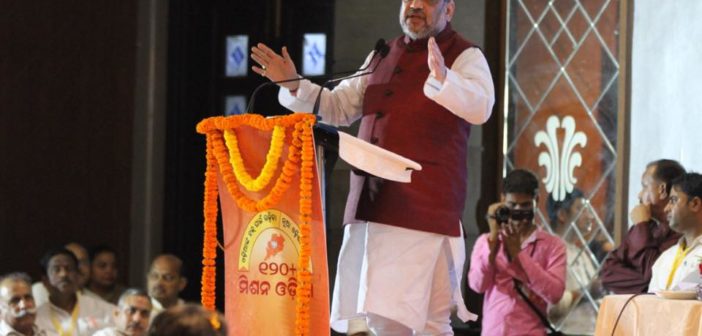Ministers and senior leaders have been asked to deliver 4 seats each, and is also concentrating on the 113 seats that the party came second or performed impressively in the last elections. Apart from that, BJP is putting lot more emphasis on states where they don’t win seats. Although, making its presence felt in states like Tamil Nadu, West Bengal and Kerala is not going to be easy for BJP but the way things are panning out and the kind of effort they are putting in, there performance is surely going to improve. And that is where, the whole task of getting 350 seats may feel like a bit too much, but as you go deeper into the methodologies and the current scenario, its achievable for BJP, Reports Vipin Agnihotri in Governance Democracy&Politics (GDP), October Issue
The pivotal factor here is that Amit Shah and the BJP might end up being victims of their own success of achieving its ‘Mission 272’ three years back, set by Amit Shah who was in-charge of Modi’s election strategy then, as in many areas the BJP seems to have reached saturation point. Which could be seen in states such as Uttar Pradesh, Bihar among others, where the party and its alliance partners won an unexpectedly high number of seats. So to achieve the latest target, BJP have to so something very ‘special’.
And it does not look probable. In Uttar Pradesh, things under Yogi Adityanath have not gone according to plan. There are internal battles within the party and above all likely partnership between Akhilesh Yadav and Mayawati will surely make things spicy to say the least. Akhilesh Yadav as a leader is quite popular among masses and Mayawati has always been a dark horse. Whenever someone say, Mayawati style of politics is done and dusted, she come back with a vengeance.
Congress is also putting in the hard yards and even if Akhilesh-Mayawati combination is not going to click, BJP is not going to repeat the same staggering result, come 2019. In Bihar too, Lalu Prasad Yadav recent rally at Gandhi Maidan clearly depicts, RJD is here to stay and is going to create quite a bit of hurdles on the path of BJP, even if Nitish Kumar is in their corner.
Anti-incumbency at the centre is also going to play a part, especially with the scrutiny of demonetisation is going to open up very soon. As is can be the case in states such as Madhya Pradesh, Haryana, Chhattisgarh and Rajasthan. Resentment against chief ministers can easily turn into that for the leader at the centre.
Facts And Figures
BJP has 282 seats in the current Lok Sabha. To attain 350, the party has to increase its tally by 68 seats, or a full 24 per cent. Three years back, the BJP won 190 out of a total of 207 seats in nine states, including all seats in Gujarat, Rajasthan, Delhi and Uttarakhand. It can’t do any better in these four states. On the other hand, in Uttar Pradesh, it won a phenomenal 71 out of 80 seats. It may be difficult to hold on to this number. Even if there is no grand united opposition alliance, 71 is a hard number to defend. Though it’s not beyond the realm of possibility, given the results of the UP assembly polls.
In 2014, the party won 27 out of the 29 seats in Madhya Pradesh, and 12 out of 14 in Chhattisgarh. Both states have had BJP governments for more than ten years and there is bound to be the anti-incumbency factors at play in these states. Looking at the positive side of things, BJP has made deep inroads into the North East. And that is where, it will definitely gain seats in the region. It will also raise its tally in Karnataka (17 out of 28 in 2014), Odisha (one out of 21), Maharashtra (28 out of 43), and Andhra Pradesh (two out of 25).
Furthermore, blatant minority appeasement in Telangana and West Bengal will help the BJP, though more in Telangana than in the eastern state where Mamata Didi seems set to rule till retirement — and politicians never retire. In Bengal, BJP is now the principal opposition party; Congress and the Left Front have been decimated, as the results of the recent civic polls in the state highlight.
Frequent Travel, Surveys And So On
GDP has learned that leaders have been told to frequently travel to seats where BJP is not at ease. They are given a clear direction to complete at least 40 such trips in the run up to the polls. Surveys and assessments will be conducted on a quarterly basis on these seats after every three to four months. Ministers and leaders have been told to meet important people in these constituencies, intellectuals, workers, farmer groups, community leaders. Another significant thing is that in the hit list of BJP is to make sure party workers avoid staying in fancy hotels with ministers specifically being told to not use official vehicles for any of this work. Looks like, after a marathon 110-day tour across India for organisational expansion, Amit Shah’s ambitions seem to have gotten bigger, and plans more structured.





